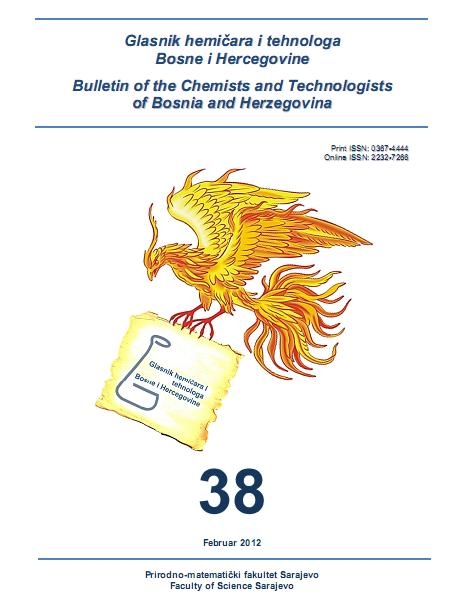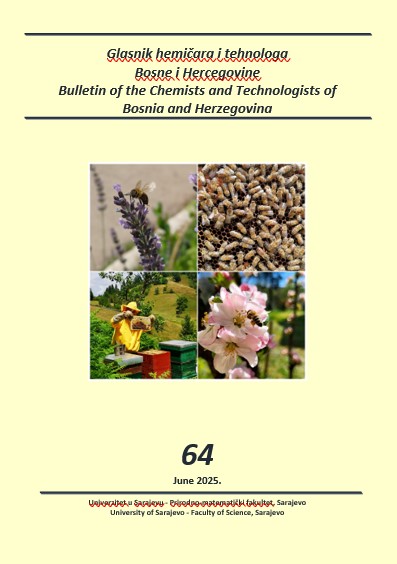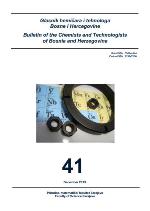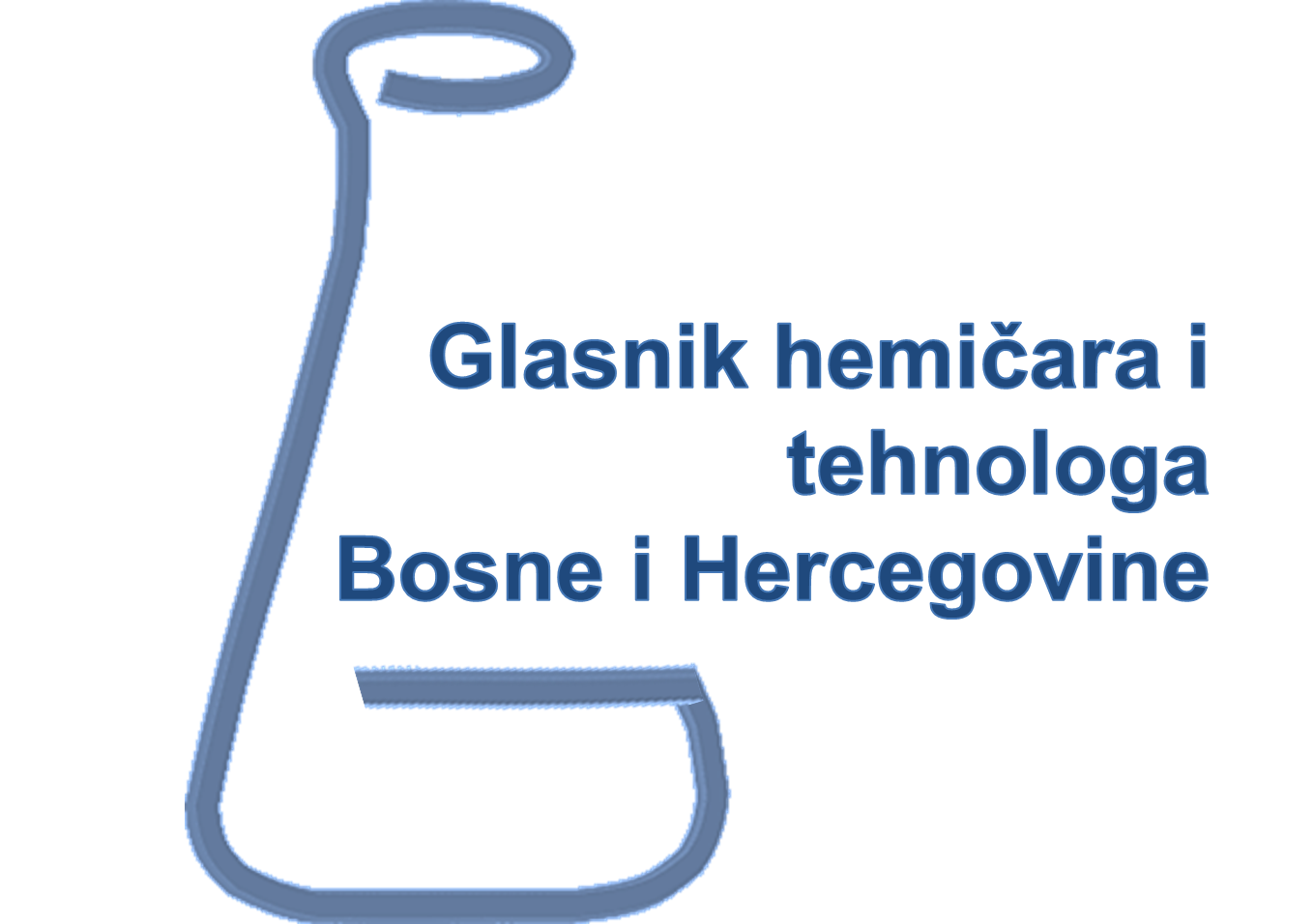|
|
Bulletin of the Chemists and Technologists of Bosnia and Herzegovina
Issue 38
Publication date: July 2012 |
Table of contents
Three novel 4-methylcoumarin derivatives Original Scientific Article
Ćavar Sanja, Kovač Franci
Abstract: Substituted 4-methylcoumarins are synthesized from phenols and ethyl acetoacetate via Pechmann condensation, then, using common method for benzoylation, three novel coumarin derivatives were obtained: 4-methyl-2-oxo-2H-chromen-6-yl benzoate (2a), 4,5-dimethyl-2-oxo-2H-chromen-7-yl benzoate (2b), and 4-methyl-2-oxo- 2H-chromen-7,8-diyl benzoate (2c). The structures of novel coumarins were characterized by elemental analysis, GC/MS, NMR, and IR techniques.
Bulletin of the Chemists and Technologists of Bosnia and Herzegovina 38, 1-4.
High-order above-threshold ionization and high-order harmonic generation of molecule: a way of its characterization Original Scientific Article
Gazibegović-Busuladžić Azra, Hasović Elvedin, Odžak Senad, Busuladžić Mustafa, Milošević B. Dejan
Abstract: We investigate high-order above-threshold ionization (HATI) and high-order harmonic generation (HHG) of diatomic molecules having different symmetries by a strong laser field using modified molecular strong-field approximation. We present our results for N2, O2, H2, and Ar2 molecules. Their initial highest occupied molecular orbitals are characterized by 3σg, 1πg, 1σg, and 5σ usymmetry, respectively. By analyzing HATI and HHG spectra for different molecular orientation with respect to the laser polarization axis, and for different values of the electron or photon energies and electron emission angle, we are able to draw some conclusions about the molecular structure. The most noticeable feature of all molecular spectra is the existence of minima that are absent in the atomic case.
Bulletin of the Chemists and Technologists of Bosnia and Herzegovina 38, 5-12.
Comparison of x-ray fluorescent analysis and cupellation method for determination of gold in gold jewellery alloy Original Scientific Article
Jotanović Aida, Memić Mustafa, Suljagić Šemsa, Huremović Jasna
Abstract: To make jewellery of gold, gold is alloyed with other metals. It is of great importance to accurately determine the total amount of pure gold in alloys used for making the jewellery and in jewellery made of gold, because it determines its value on the market. Several analytical methods are used for this purpose. This study was based on comparison of results of analysis of gold alloy for 14-carat jewellery obtained by non-destructive fluorescent analysis method and destructive cupellation method. The null hypothesis with 95% confidence level on equivalence in measurement precision of perecnt by percent mass of gold in three very similar gold alloy samples in reproducibility condition (three measurement series) for standard cupellation method and the method compared (validated), XRF method, has been confirmed. F-test did not confirm null hypothesis on precision equivalence for two mentioned analysis methods. There is a significant difference in variance values. However, the t-test was carried out, which verified the null hypothesis on equivalence between mean values of results achieved in two compared values. In order to confirm applicabilty of two methods, Z score was calculated giving values of less than 2, using statistical data from inter-laboratory program with 62 participating laboratories applying cupellation method, and 60 laboratories applying XRF method for analysis of gold alloy used in production of 14-carat jewellery.
Bulletin of the Chemists and Technologists of Bosnia and Herzegovina 38, 13-18.
Electrochemical characteristics of welded joints on stainless steel in maritime atmosphere Original Scientific Article
Korać Fehim, Gutić Sanjin, Semić Inesa, Kozica Indira, Gojak Sabina, Islamović Safija, Ostojić Jelena
Abstract: Maritime atmosphere represents the corrosion environment characterized by air saturated with chloride. Many different factors affect the quality of welded joint and the material around it. In case of welding of steel structures, those factors include selection of the welding process, an additional electrode material, and type of lining. Stainless steel is used for different equipment that is exposed to sea water. Connecting those parts together is done by welding method whose quality depends on a number of factors. Some of those factors are investigated in this study. Samples used in experiments are X5CrNi 18-10ASTMAISI304 stainless steel sheets of austenitic type. This sheet is welded in two different ways: manual arc welding in a protective atmosphere of argon and manual arc welding with covered rutile electrode. Corrosion characteristics have been investigated for three distinct zones: zone of welded joint itself, zone in the vicinity of welded joint and zone far from welded joint (basic material). Tests were performed in 0.9% and 3% NaCl solution, as well as in sea water samples from the area of Dubrovnik and Ploče (brackish water). Electrochemical study has been performed by means of potentiodynamic polarization between -0,150V and 0,350V vs. saturated Ag/AgCl electrode. Results obtained for X5CrNi18-10 austenitic steel and its welded parts in different media at room temperature indicate some degree of self-passivation along with uniform corrosion processes. Based on the obtained results, we concluded that values of corrosion potential lie between 0.350V and -0.150V, depending on the environment in which each sample is probed. In the case of sample welded with dross, increase of corrosion rate does not follow increment of chloride concentration in the expected extent. Corrosion processes are mostly located on the ZUT-OM interface. For the majority of samples, welding in argon atmosphere proved to be a more acceptable way of processing metals from the aspect of corrosion resistance.
Bulletin of the Chemists and Technologists of Bosnia and Herzegovina 38, 19-24.
Structure of blue copper proteins: electron-transfer kinetics of Cu(II/I) copper complex with macrocylic ligand with N2S2 donor set Original Scientific Article
Galijašević Semira
Abstract: In electron-transfer, the change in the oxidation state of the reactants is generally accompanied by structural changes, which influence the electron-transfer kinetics. Previous studies on the systems of Cu(II/I) complexes involving cyclic tetrathiaether ligands indicated that inversion of coordinated donor atoms may be a primary factor in controlling gated electron transfer. Complex formation and isopmerization studies on [14]aneN4 type complexes have demonstrated that coordinated N atoms are shown to invert since they must undergo a hydrogen abstraction prior to inversion. In the systems with [14]aneNxS4-x ligands, there is a choice of N or S inversion. This study has been conducted to determine the effect of inversion of coordinated N atoms on electron-transfer rates as a function of different concentrations of water as hydrogen ion acceptor existing in aprotic solvent (acetonitrile). Data on electron-transfer kinetics are presented here. Possible conformational changes and kinetics pathways for N-S mixed donor complexes are discussed.
Bulletin of the Chemists and Technologists of Bosnia and Herzegovina 38, 25-30.
Determination of mercury in the urine by atomic absorption spectrometry – cold vapor technique Original Scientific Article
Kešeljević Bojan, Huremović Jasna,Sulejmanović Jasmina
Abstract: Urine is a liquid waste product of the body. Substances that are ingested and fail to be apsorbed are excreted, solid waste through the intestines, the urine through the kidney and ureter and another fluid from the body through perspiration. Determination of mercury content of urine is not included in routine examinations, but mercury can be present in urine at concentrations that could have serious effects on human health. Urine donors were selected in regard to their occupations, age, lifestyle habits, and different diet, with special reference to dental professionals, consumers of marine food and smokers, as a group of subjects that could have a higher concentration of this metal. To determine the mercury content in urine ,atomic absorption spectrometry – a tehnique of cold vapor method was used The total content of mercury in 76 analyzed urine samples was in the range of 0.12 to 12.24 ng/mL. There was a positive correlation between the number of teeth with amalgam fillings and urinary concentrations of mercury in some donors,. In contrast, the other analyzed factors that theoretically can affect the levels of mercury inurine, did not show such correlation.
Bulletin of the Chemists and Technologists of Bosnia and Herzegovina 38, 31-34.
Total phenolic content and antioxidant activity of ethanolic extracts of Aesculus hippocastanum L. Original Scientific Article
Otajagić Senada, Pinjić Dženana, Ćavar Sanja, Vidic Danijela, Maksimović Milka
Abstract: Aesculus hippocastanum L. (horse chestnut) belongs to the genus Aesculus, the most widespread genus of the Hippocastanaceae family, and it is native to the countries of the Balkan Peninsula. Different parts of the plant were used for the treatment of many diseases. Total phenolic content of ethanolic extracts of bark of twigs and fruit and fruit itself was evaluated by Folin-Ciocalteu method while antioxidant activity was tested using DPPH (2,2-diphenyl-1-picrylhydrazyl) radical scavenging method. Preliminary investigation of chemical composition was done by TLC and aesculin was detected in samples of bark of twigs. Results for content of total phenolics were expressed as gallic acid (mg GAE/mL) and aesculin (mg AE/mL) equivalents, respectively. Among the tested samples, the highest amounts of total phenolics were detected in all bark extracts, 763.53- 1048.00 mg AE/mL, while samples of pulp had the lowest content of these compounds, 43.41-66.15 mg AE/mL. All bark extracts showed higher antioxidant activity than aesculin which was used as a standard, while extract of pulp mixed with bark showed significantly lower antioxidant potential.
Bulletin of the Chemists and Technologists of Bosnia and Herzegovina 38, 35-38.
Spectrophotometric analysis of total ascorbic acid content in various fruits and vegetables Original Scientific Article
Kapur Ajla, Hasković Alisa, Čopra-Janićijević Amira, Klepo Lejla, Topčagić Anela, Tahirović Ismet, Sofić Emin
Abstract: Total ascorbic acid (ascorbic acid + dehydroascorbic acid) has been determined in twenty-one different samples of fruits and vegetables by spectrophotometric method. This method is based on the oxidation ascorbic acid to dehydroascorbic acid by bromine water in the presence of acetic acid. After coupling with 2,4-dinitrophenylhydrazine (DNPH) a red complex was produced and absorbance of that complex was spectrophotometrically measured at 521 nm. A linear concentration range for standard solutions of ascorbic acid was obtained up to 10 μg mL-1, with a correlation coefficient of 0.9929. The contents of ascorbic acid were found between 9 and 49 mg/100 g of fresh fruits, also 3 and 90 mg/100 g of fresh vegetables. The interferences of glucose, fructose and sucrose were also investigated. The limit of detection of ascorbic acid was found to be 0.01 μg mL-1 (3σ from 10 measurements of ascorbic acid concentration of 3 μg mL-1), and limit of quantification of ascorbic acid was 0.017 μg mL-1. A relative standard deviation was 2.4% (n = 10, c = 7 μg mL-1). The content of total ascorbic acid in twenty-one different samples of fruits and vegetables was compared with results of spectrofluorimetric method and literature values.
Bulletin of the Chemists and Technologists of Bosnia and Herzegovina 38, 39-42.
Integrated knowledge of physics and chemistry: case of Physical Chemistry course Original Scientific Article
Gojak Sabina, Galijašević Semira, Hadžibegović Zalkida, Zejnilagić-Hajrić Meliha, Nuić Ines, Korać Fehim
Abstract: One of the major achievements of the learning process is acquisition of integrated knowledge. This paper presents the first results of the degree of knowledge of the second year chemistry students in subjects relevant to the objects of physical chemistry. Data was collected using questionnaires and tests given out to students of chemistry in the academic year 2010/2011. The first results obtained show a weak and insufficient integration of knowledge in general chemistry, general physics and mathematics required for further subject courses such as physical chemistry. The negative difference in the number of points on the pretest and posttest (the results are lower for 80% of questions on the posttest) was detected, although the test was repeated after the end of the winter semester and completion of Physical chemistry course. This poor performance on tests can be an indicator of a number of difficulties in the learning process, which are identified through this research in attempt to find correct solution for this problem.
Bulletin of the Chemists and Technologists of Bosnia and Herzegovina 38, 43-51.





 Full text PDF
Full text PDF 


